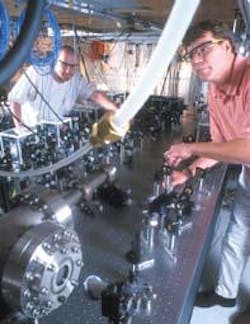
Physicists at the Georgia Institute of Technology (Atlanta, GA) have demonstrated the first all-optical technique for producing Bose-Einstein condensates, a form of matter in which atoms cooled to a fraction of a degree above absolute zero (-273.15°C) cease their normal motion and enter a single quantum state. The researchers report that the new method is simpler, faster, and more flexible than the magnetic confinement technique currently used to produce the condensates. Dispensing with magnetic confinement should also allow the technique to be used on a wider variety of atoms, atomic mixtures, and even molecules.
"The simplicity of the technique and its speed are somewhat remarkable, given that people have been trying to produce all-optical Bose-Einstein condensation for so long," said Michael Chapman, an assistant physics professor at Georgia Tech.
Operating inside a vacuum chamber, the process relies on an all-optical technique—a crossed-beam optical dipole force trap using two tightly focused, high-powered (12 W) infrared CO2 laser beams (l = 10.6 µm)—to confine a cloud of gaseous rubidium-87 (Rb-87) atoms during evaporative cooling. To bring about the final cooling step, immediately after loading the trap from a CO2 laser-cooled gas, the researchers rapidly reduce the power and lower the depth of the confinement. This forces the hottest atoms to evaporate, forming the Bose-Einstein condensate in just 2 seconds—several times faster than the magnetic process. The resulting condensates are F-1 three-component spinors.
Chapman and his team produced condensates containing up to 35,000 atoms and believe there is no fundamental reason to prevent scaling the optical process up to match the millions of atoms captured by magnetic means.
Physicists have attempted to produce condensates through optical means for years. Chapman doesn't yet know why his team succeeded where others have failed, but speculates that the CO2 lasers or the Rb-87 isotopes may have provided an edge. Carbon dioxide lasers can be precisely controlled to avoid transferring energy to the atom cloud, and the Rb-87 isotope has properties more favorable than the Rb-85 studied by other researchers.
"A lot of the excitement about atomic Bose-Einstein condensates is that this sort of coherence—getting all the atoms into one state and to do everything at the same time—could eventually lead to some interesting developments," explains Chapman. "Where this will lead to is hard to predict, but historically whenever we've been able to get more control over physical systems, it has led to dramatic new directions in science and technology."
Though potential applications remain far in the future, the Bose-Einstein phenomenon has attracted intense interest because it could do for atoms what lasers have done for photons. To be useful in an application such as quantum computing, the technique must be scaled up to control thousands of atoms individually. Atomic lithography, coherent-matter wave optics, and coherent interferometry are also among the possible applications.
About the Author
Sally Cole Johnson
Editor in Chief
Sally Cole Johnson, Laser Focus World’s editor in chief, is a science and technology journalist who specializes in physics and semiconductors.
